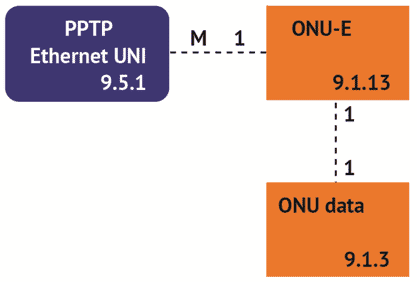An ONU (Optical Network Unit), used in a PON (Passive Optical Network) as a user’s side equipment, has many services and features in its specifications. The OMCI (ONU Management Control Interface) standard (ITU-T G.988) specifies a protocol used by the Optical Line Terminal (OLT) to configure and manage the ONU to meet customer requirements.
This information is managed using a protocol-independent MIB (Management Information Base). Like a Lego construction, a MIB consists of smaller pieces – MEs (Managed Entities). Each ME is an abstract depiction of one of the many resources and services in an ONU.
Some of MEs can describe physical elements, such as equipment slots or ports of different types. They can also represent logical entities with no direct mapping into hardware, such as “ONU data”, which defines the MIB itself. There are some MEs which model only a small piece of the configuration and can only be used in conjunction with others, such as a GEM (GPON Encapsulation Method) port representation, which is described as a subset of several MEs linked together.
G.988 defines a large number of different types of MEs. Only a small group of them is mandatory (ANI-G, ONU-G, T-CONT, etc.); the rest are optional, depending on vendors’ hardware and the list of features to be supported (GAL Ethernet profile, IEEE 802.1p mapper service profile, MAC bridge related MEs, etc.).
The MEs should be sorted and linked together in a way that logically represents the configuration. As with a Lego construction, there are many possible designs with valid configurations for an ONU. MEs are usually depicted in the relational diagram with implicit/explicit connections and numbers of instances of particular ME used in the model’s scheme.
There is a common format for describing MEs and their important characteristics, such as their attribute values, supported actions, notifications, and their relationships with other MEs.
Some of the MEs (especially related to hardware) can be instantiated autonomously by the ONU itself, some can be created at the request of the OLT, and some by either of them. The access attribute can be set to Read (R), Write(W), or both (R, W) for MEs instantiated by the ONU, and the same subset plus (R, set-by-create) or (R, W, set-by-create) for MEs instantiated by the OLT. Some of the common actions for MEs are: “create”, “delete”, “get”, and “set”. There are also few specific actions that are related to a particular ME type, such as “MIB reset”.
As for notifications – MEs generate them for various alarm conditions, performance monitoring threshold crossing alerts, and attribute value changes initiated by the ONU.
All MEs have a Managed Entity identifier. The ID can be set to 0, when there is only one of its type, and an ME can have the same ID as the MEs of different types to show their connection. Commonly, MEs of the same type are given IDs that are sequential values so that they can be handled in an array fashion. This approach is well-suited for different types of ports and queues.
As an example, below is the relational diagram for point-to-point gigabit Ethernet-fed ONUfrom the G.988 standard:

This point-to-point gigabit Ethernet-fed ONUmodel in Pic.1 shows three MEs, all created by the ONU. The ONU-E represents the ONU itself., and the “ONU data” ME represents the MIB. Clearly, there’s a one-to-one relationship between these two entities. The diagram also shows a PPTP UNI entity and indicates that the ONU-E can include many of these.
The MIB entity (ONU data) has just two attributes, one of which is the Managed Entity ID and the other “MIB data sync”, used by the process responsible for synchronizing the MIB between the OLT and the ONU. This ME also has unique actions to work with the MIB, including the aforementioned “MIB reset”, “MIB upload”, and “MIB upload next”.
Support of new features and services described in the G.988 standard requires a good understanding of:
- The capabilities of the required types of MEs
- How MEs can be used
- How these MEs will be connected, and what their dependencies are
- Correct system configuration in a specific order with right values
- Configuration management, including enabling/disabling elements at runtime
- Fault management, including support and handling of alarms for certain MEs
- Performance management including performance monitoring data using dedicated MEs
Working with our partners, IP Infusion Innovations has the expertise to help our customers address the challenges of developing OMCI features and delivering new solutions to the market.

